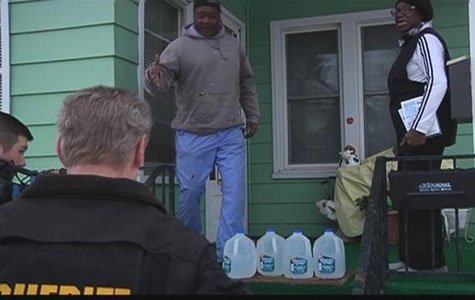(CNN) — The best fiction has a way of using an imagined world to help us see the real one more clearly. I was reminded of that when I recently read “The Ones Who Walk Away from Omelas.”
On the surface, Ursula Le Guin’s 1973 short story is unrelated to a topic I have been thinking a lot about in recent months, namely the lead in water crisis in Flint, Michigan. But I couldn’t help but feel that, in some ways, it describes the community of experts who enabled not only the Flint crisis, but a similar problem in Washington over a decade ago. It also seems to illuminate the kind of thinking behind a daily gamble that’s taking place across the United States with the lives and futures of fetuses, infants, and young children who drink (or eat food cooked with) lead-tainted tap water.
Omelas is a “happy” town in celebration of the “victory of life,” but with one secret. In a small broom closet it keeps locked up a child that is “nearly 10,” though “looks about 6.” The child is described as “feeble-minded” — perhaps from birth or through years of isolation and neglect. Omelas’ citizens know about the child, and some even go stare at it, but they are caught up in a disturbing belief that its release would bring immediate destruction to the beauty and prosperity of their town.
I have worked on the problem of lead in drinking water for nine years, and I am haunted by what I see as a present-day Omelas in our midst, involving agencies whose responsibility it is to promote the public good: water utilities, the Environmental Protection Agency (EPA), and the Centers for Disease Control and Prevention (CDC).
These bodies pride themselves on delivering clean water, protecting our environment, and safeguarding our health. But the awkward truth is that through a weak federal regulation, a pernicious cycle of misinformation, and systematic disregard of public demands for change, they leave millions of U.S. citizens vulnerable to chronic and acute exposures to lead in drinking water.
Recent scientific studies have associated such exposures to miscarriages and fetal deaths as well as to elevated levels of lead in blood in young children. The severity and irreversibility of the harm involved suggests large-scale failure by a community of otherwise well-meaning professionals that seems to be caught up in the misplaced belief that improved protection from lead in water is either unnecessary or would somehow involve greater costs than what we are now paying.
So what is the regulation that has helped fuel this crisis? The federal Lead and Copper Rule (LCR), born from a cozy relationship between the EPA and water utilities, leaves consumers partly responsible for protecting themselves from lead at the tap. The trouble is that the rule neglects to provide an effective mechanism that lets us know about this responsibility.
Of course, there is no safe level of lead in water. However, the LCR deems utilities compliant when more than 90% of a small number of sampled homes release lead equal to or below 15 parts per billion (ppb). This means that when our drinking water is hailed for “meeting or exceeding” federal standards, and we take comfort in that news, every home in our community could in theory be dispensing up to 15 ppb lead — and 10% of homes could be dispensing lead in the hundreds and even thousands of ppb.
If that weren’t bad enough, investigations in 2004 and this year suggested that water utilities game the LCR, which can artificially earn them regulatory compliance and prolong public exposure to severe contamination. This happened in Washington, Durham, and Flint.
Unfortunately, according to a 2006 EPA review, even when widespread problems are confirmed, and the LCR’s remediation requirements are triggered, the majority of utilities failed to provide mandatory public education. We are witnessing a case like this today in Sebring, OH, where the water system was found to have been too slow to notify its customers of lead in their water.
What is EPA doing about this?
So far, the EPA has failed to heed public calls for urgent fixes to the LCR, and affected communities were not included in the LCR-revisions deliberations working group that it convened in 2014. Perhaps not surprisingly, the working group did not propose a ban to well-known gaming practices. I was the only dissenter to the report the group released. And the CDC? It designates lead paint and dust as the primary sources of lead, and has systematically downplayed the risk of lead in water.
Perhaps informed by this mindset, Holland, Michigan — which reportedly faces a significant problem with elevated blood lead levels in children — recently made the surprising announcement that its takeaway lesson from Flint’s water crisis was the need to address lead paint. “Unlike Flint, Holland does not have any issue with lead in the water,” a city representative said. Forget that the city’s water utility has gamed the LCR.
So the Omelas I see weighs heavily on me. But we cannot walk away from it, like some did in Le Guin’s story, and we cannot turn a blind eye. Instead we should demand honest public messaging, and continue to fight for a rule on lead that will protect us all.
Yanna Lambrinidou is adjunct assistant professor of Science and Technology Studies at Virginia Tech. The views expressed are her own.
The-CNN-Wire
™ & © 2016 Cable News Network, Inc., a Time Warner Company. All rights reserved.
